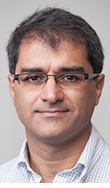First-year design studio tackles architectural lighting challenge

Alireza Borhani
First-year Texas A&M environmental design students vaulted into the vast world of architecture this month tackling a studio project that challenged them to cast natural light around a corner and deep into the darkest recesses of structure.
Architecture lecturer Alireza Borhani tasked students with designing and fabricating an L-shaped building model through which light could move vertically down a long chimney, then horizontally to illuminate a painting at the far end of a dark room. Limited only to designs that could be replicated at full scale, students used mirrors, prisms and even water to conduct light into darkness.
The point of the exercise was not just to move light 90 feet, but to familiarize students with design software and the College of Architecture’s state-of-the-art Automated Fabrication and Design Lab, said Borhani. The exercise, without an easily reproducible precedent, was also crafted he said, to bolster students’ confidence, encourage risk-taking and creativity in design.
“The ultimate lesson I can share with my students is to recognize mistakes quickly,” he said. “Each failure opens more opportunities for success.”
One team’s initial design failure eventually became “the most beautiful idea” in the challenge, said Borhani.
It took four design iterations for Jared Labus of Floresville, Texas and Sean Nimmons of Houston to create a structure in which half-spheres filled with water magnified incoming light, creating a mesmerizing, undulating light on the painting.
“It was difficult and it pressed the extent of what we thought we could do,” Nimmons said. “But after all the trial and error, we made something beautiful.”
Other teams used mirrors and prisms to capture and move light into the structure with various levels of success.
“Light is very difficult to control,” said 18-year-old Gage Finke of Comfort, Texas, as he demonstrated his double-helix plexiglass and mirror model at the Oct. 6 review. His design was beautiful in symmetry and appearance, but unable to draw light to the painting.
In another project, Sarah Hluza, from Houston, and Danielle Benavides, from Laredo, Texas, created a light chimney lined with rectangular mirrors at 45- and 60-degree angles.
“We wanted to capture the sun no matter where it was in the sky,” said Hluza. “It doesn’t do the best job of getting the light to the painting, but considering it was our first project as architecture majors, it was very rewarding.”
The month-long project, said Borhani, gave students confidence to design future projects and exposed them to the full cycle of design, from concept to the realization of a working prototype.
“They cannot call themselves designers or architects yet, but they have made something and have a better understanding of the architectural world,” Borhani said.
Sarah Wilson
swilson@arch.tamu.edu
Tags
Related Posts

Arch students craft rule-free virtual reality worlds
Forum features fortune cookie-fashioned form

Simple panels lead to complex forms in student workshop

Student-designed playscapes thrill daycare children
Follow Us
Facebook Twitter Vimeo Youtube Flickr RSS
Recent Posts

Planning prof heads study of disaster housing aid

A message from the dean

Former student remembered as expert planner

Leading educator named new head of Architecture Dept.











_thumbnail_small.png)
